Strategic Development Tools: PESTEL, SWOT, RBV, and Ansoff Matrix
VerifiedAdded on 2023/01/23
|12
|1935
|100
Report
AI Summary
This report provides an in-depth analysis of four key strategic development tools used by businesses: PESTEL, SWOT, Resource-based View (RBV), and Ansoff Matrix. The PESTEL analysis examines external factors impacting businesses, such as political, economic, social, technological, environmental, and legal factors, using Tesco as an example. SWOT analysis identifies a company's strengths, weaknesses, opportunities, and threats, illustrated by a case study of Reebok. The Resource-based View (RBV) focuses on internal resources and capabilities, employing the VRIO framework, with PepsiCo as a case study. Finally, the Ansoff Matrix presents strategies for future growth, including market penetration, market development, product development, and diversification, exemplified by Nestle. The report concludes by highlighting the importance of these tools in achieving a sustainable competitive advantage for businesses across various industries.
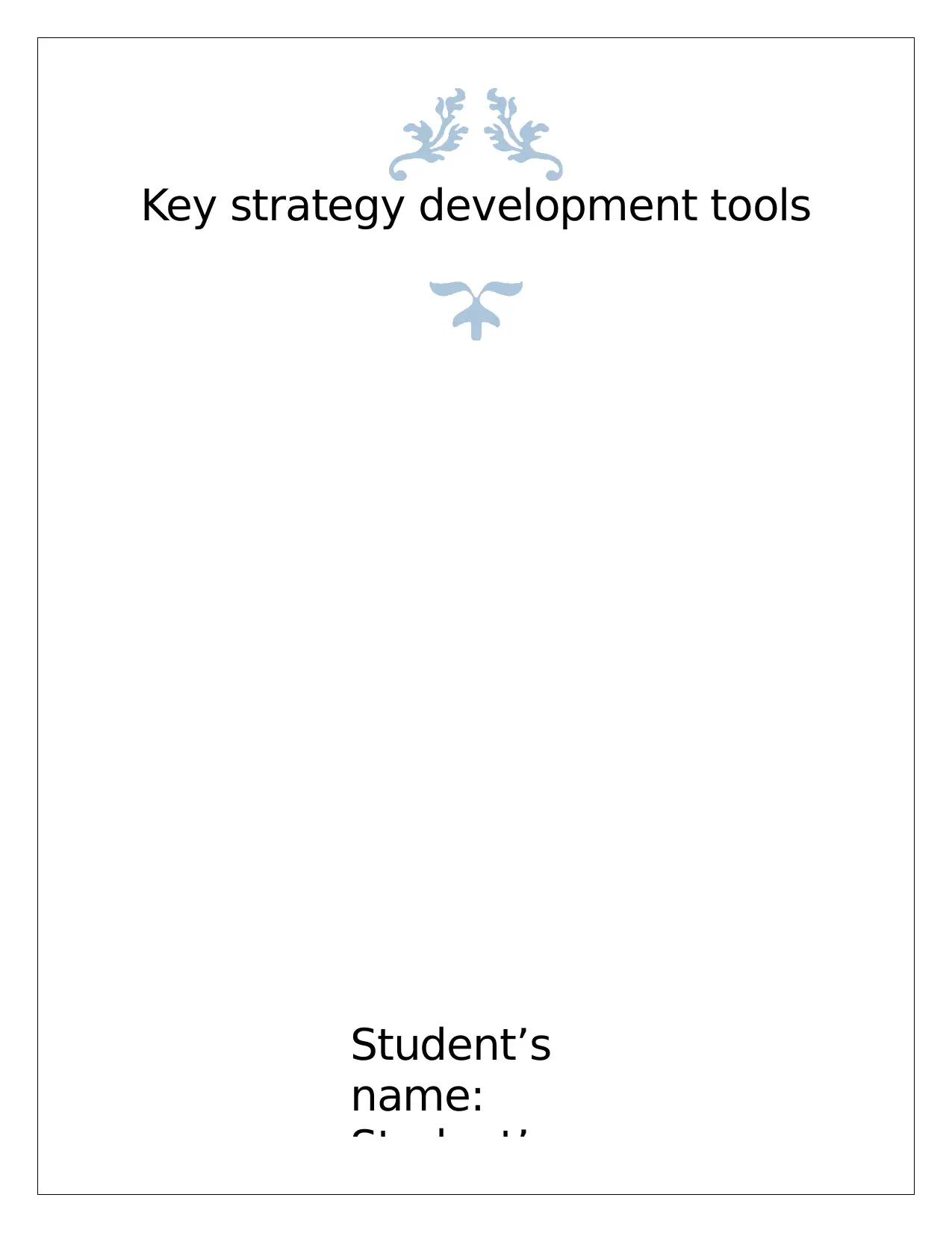
Key strategy development tools
Student’s
name:
Student’s
Student’s
name:
Student’s
Paraphrase This Document
Need a fresh take? Get an instant paraphrase of this document with our AI Paraphraser
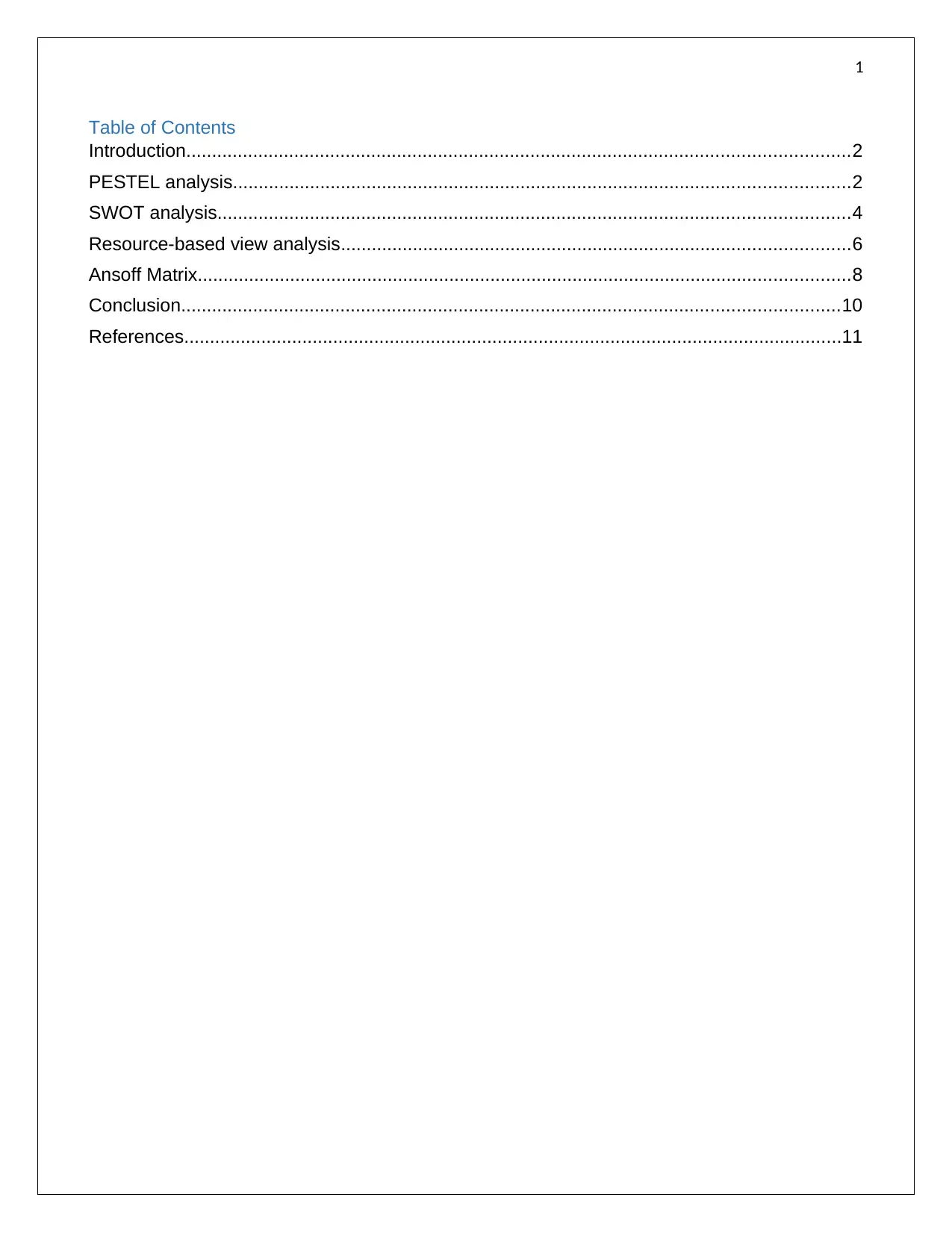
1
Table of Contents
Introduction.................................................................................................................................2
PESTEL analysis........................................................................................................................2
SWOT analysis...........................................................................................................................4
Resource-based view analysis...................................................................................................6
Ansoff Matrix...............................................................................................................................8
Conclusion................................................................................................................................10
References................................................................................................................................11
Table of Contents
Introduction.................................................................................................................................2
PESTEL analysis........................................................................................................................2
SWOT analysis...........................................................................................................................4
Resource-based view analysis...................................................................................................6
Ansoff Matrix...............................................................................................................................8
Conclusion................................................................................................................................10
References................................................................................................................................11
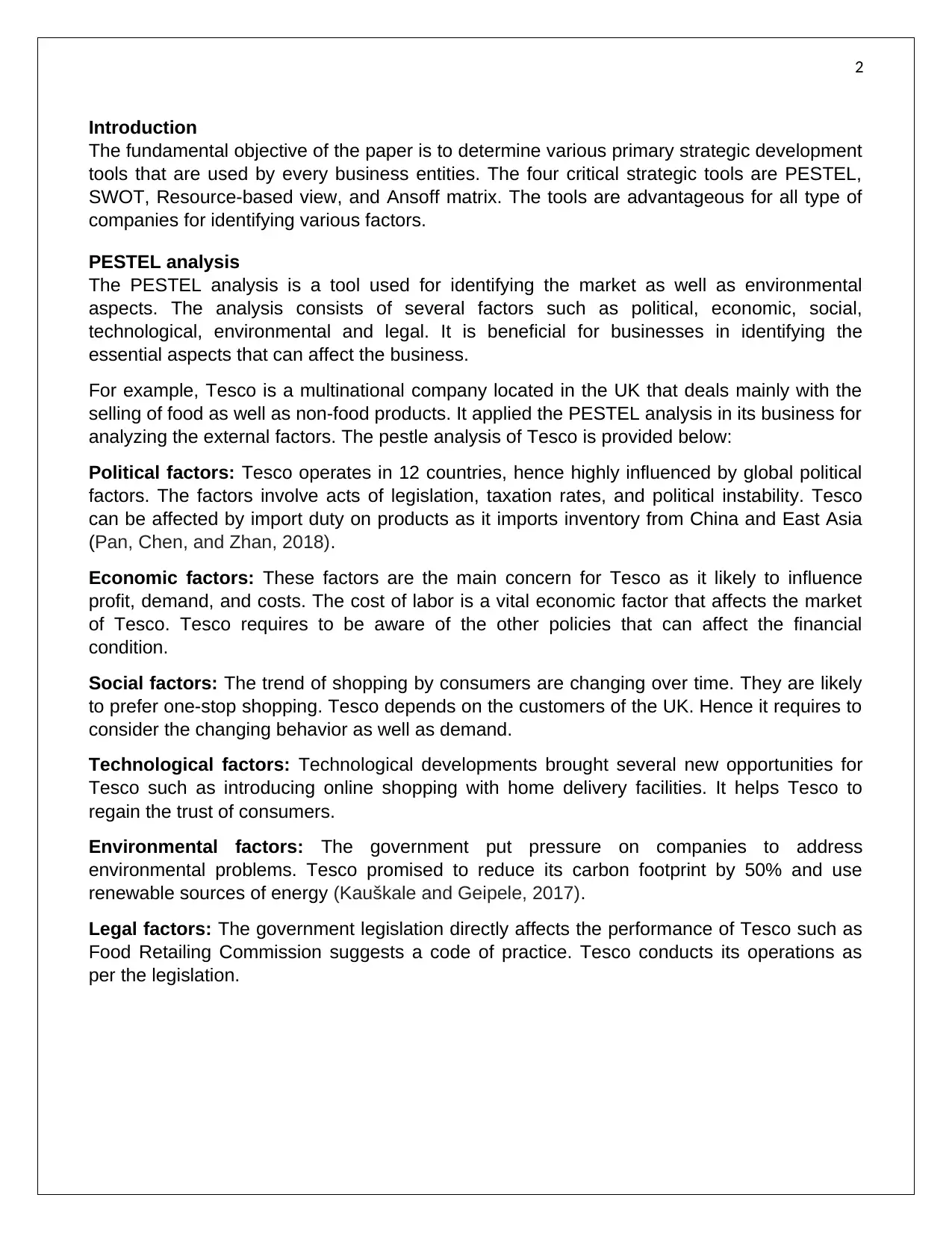
2
Introduction
The fundamental objective of the paper is to determine various primary strategic development
tools that are used by every business entities. The four critical strategic tools are PESTEL,
SWOT, Resource-based view, and Ansoff matrix. The tools are advantageous for all type of
companies for identifying various factors.
PESTEL analysis
The PESTEL analysis is a tool used for identifying the market as well as environmental
aspects. The analysis consists of several factors such as political, economic, social,
technological, environmental and legal. It is beneficial for businesses in identifying the
essential aspects that can affect the business.
For example, Tesco is a multinational company located in the UK that deals mainly with the
selling of food as well as non-food products. It applied the PESTEL analysis in its business for
analyzing the external factors. The pestle analysis of Tesco is provided below:
Political factors: Tesco operates in 12 countries, hence highly influenced by global political
factors. The factors involve acts of legislation, taxation rates, and political instability. Tesco
can be affected by import duty on products as it imports inventory from China and East Asia
(Pan, Chen, and Zhan, 2018).
Economic factors: These factors are the main concern for Tesco as it likely to influence
profit, demand, and costs. The cost of labor is a vital economic factor that affects the market
of Tesco. Tesco requires to be aware of the other policies that can affect the financial
condition.
Social factors: The trend of shopping by consumers are changing over time. They are likely
to prefer one-stop shopping. Tesco depends on the customers of the UK. Hence it requires to
consider the changing behavior as well as demand.
Technological factors: Technological developments brought several new opportunities for
Tesco such as introducing online shopping with home delivery facilities. It helps Tesco to
regain the trust of consumers.
Environmental factors: The government put pressure on companies to address
environmental problems. Tesco promised to reduce its carbon footprint by 50% and use
renewable sources of energy (Kauškale and Geipele, 2017).
Legal factors: The government legislation directly affects the performance of Tesco such as
Food Retailing Commission suggests a code of practice. Tesco conducts its operations as
per the legislation.
Introduction
The fundamental objective of the paper is to determine various primary strategic development
tools that are used by every business entities. The four critical strategic tools are PESTEL,
SWOT, Resource-based view, and Ansoff matrix. The tools are advantageous for all type of
companies for identifying various factors.
PESTEL analysis
The PESTEL analysis is a tool used for identifying the market as well as environmental
aspects. The analysis consists of several factors such as political, economic, social,
technological, environmental and legal. It is beneficial for businesses in identifying the
essential aspects that can affect the business.
For example, Tesco is a multinational company located in the UK that deals mainly with the
selling of food as well as non-food products. It applied the PESTEL analysis in its business for
analyzing the external factors. The pestle analysis of Tesco is provided below:
Political factors: Tesco operates in 12 countries, hence highly influenced by global political
factors. The factors involve acts of legislation, taxation rates, and political instability. Tesco
can be affected by import duty on products as it imports inventory from China and East Asia
(Pan, Chen, and Zhan, 2018).
Economic factors: These factors are the main concern for Tesco as it likely to influence
profit, demand, and costs. The cost of labor is a vital economic factor that affects the market
of Tesco. Tesco requires to be aware of the other policies that can affect the financial
condition.
Social factors: The trend of shopping by consumers are changing over time. They are likely
to prefer one-stop shopping. Tesco depends on the customers of the UK. Hence it requires to
consider the changing behavior as well as demand.
Technological factors: Technological developments brought several new opportunities for
Tesco such as introducing online shopping with home delivery facilities. It helps Tesco to
regain the trust of consumers.
Environmental factors: The government put pressure on companies to address
environmental problems. Tesco promised to reduce its carbon footprint by 50% and use
renewable sources of energy (Kauškale and Geipele, 2017).
Legal factors: The government legislation directly affects the performance of Tesco such as
Food Retailing Commission suggests a code of practice. Tesco conducts its operations as
per the legislation.
⊘ This is a preview!⊘
Do you want full access?
Subscribe today to unlock all pages.

Trusted by 1+ million students worldwide
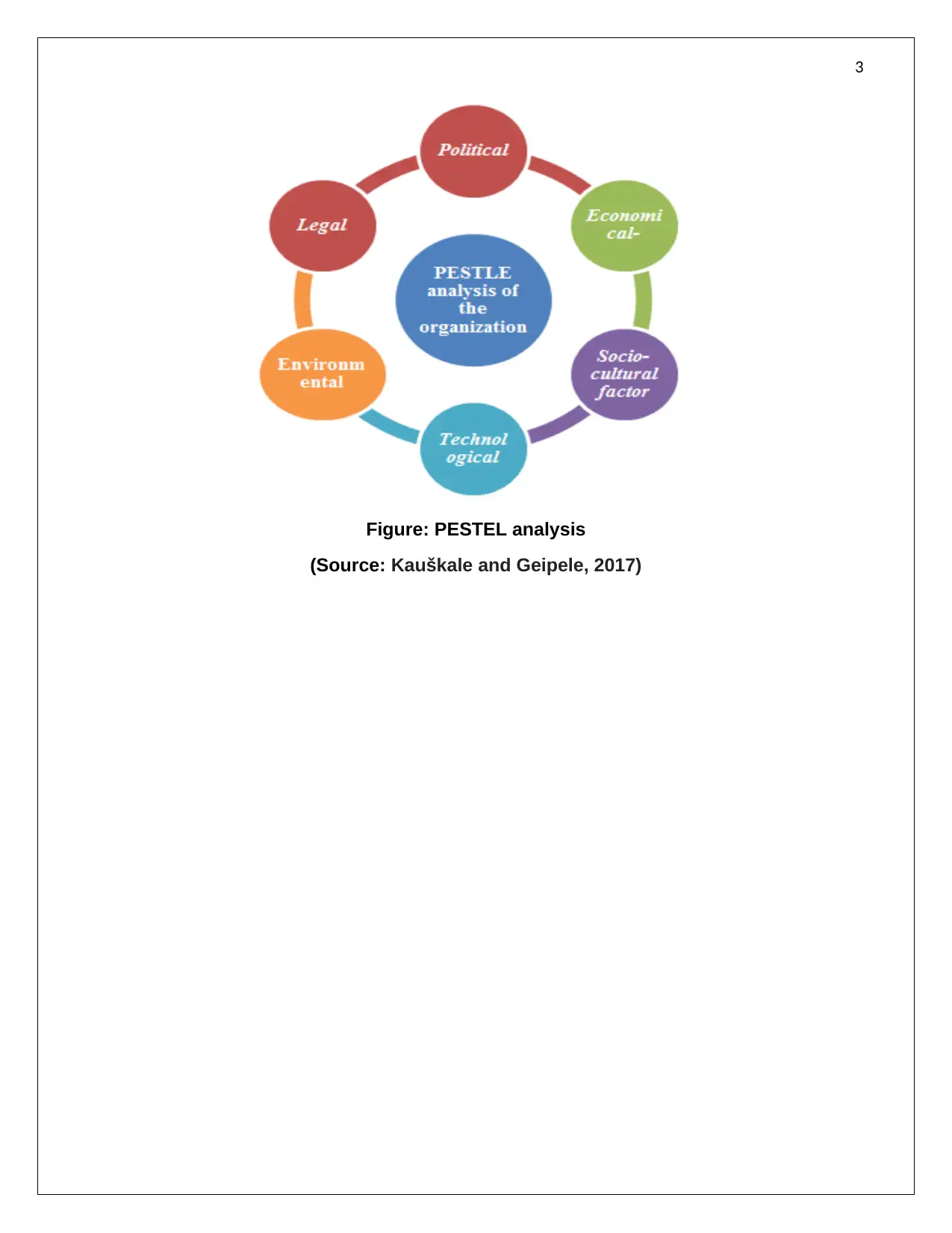
3
Figure: PESTEL analysis
(Source: Kauškale and Geipele, 2017)
Figure: PESTEL analysis
(Source: Kauškale and Geipele, 2017)
Paraphrase This Document
Need a fresh take? Get an instant paraphrase of this document with our AI Paraphraser
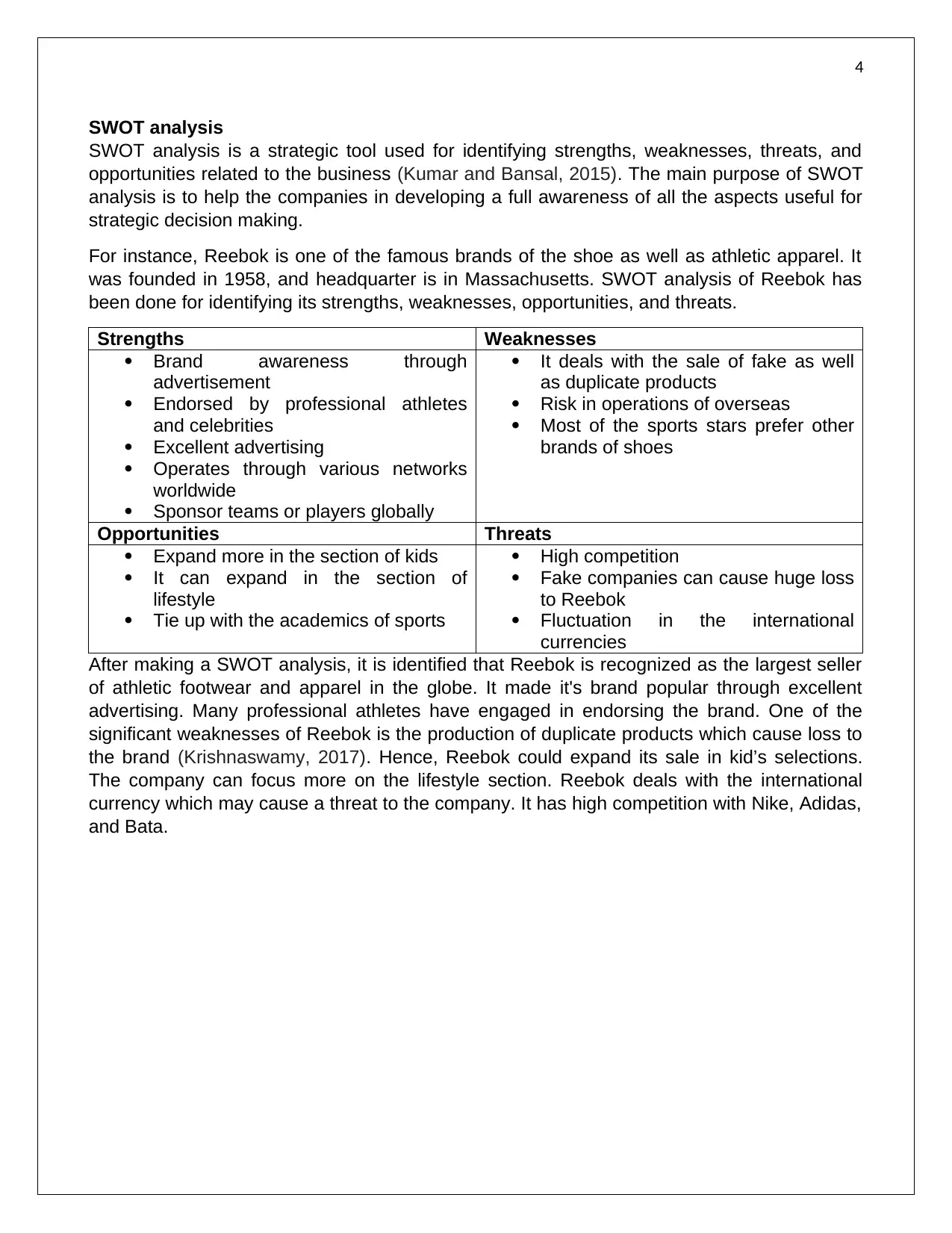
4
SWOT analysis
SWOT analysis is a strategic tool used for identifying strengths, weaknesses, threats, and
opportunities related to the business (Kumar and Bansal, 2015). The main purpose of SWOT
analysis is to help the companies in developing a full awareness of all the aspects useful for
strategic decision making.
For instance, Reebok is one of the famous brands of the shoe as well as athletic apparel. It
was founded in 1958, and headquarter is in Massachusetts. SWOT analysis of Reebok has
been done for identifying its strengths, weaknesses, opportunities, and threats.
Strengths Weaknesses
Brand awareness through
advertisement
Endorsed by professional athletes
and celebrities
Excellent advertising
Operates through various networks
worldwide
Sponsor teams or players globally
It deals with the sale of fake as well
as duplicate products
Risk in operations of overseas
Most of the sports stars prefer other
brands of shoes
Opportunities Threats
Expand more in the section of kids
It can expand in the section of
lifestyle
Tie up with the academics of sports
High competition
Fake companies can cause huge loss
to Reebok
Fluctuation in the international
currencies
After making a SWOT analysis, it is identified that Reebok is recognized as the largest seller
of athletic footwear and apparel in the globe. It made it's brand popular through excellent
advertising. Many professional athletes have engaged in endorsing the brand. One of the
significant weaknesses of Reebok is the production of duplicate products which cause loss to
the brand (Krishnaswamy, 2017). Hence, Reebok could expand its sale in kid’s selections.
The company can focus more on the lifestyle section. Reebok deals with the international
currency which may cause a threat to the company. It has high competition with Nike, Adidas,
and Bata.
SWOT analysis
SWOT analysis is a strategic tool used for identifying strengths, weaknesses, threats, and
opportunities related to the business (Kumar and Bansal, 2015). The main purpose of SWOT
analysis is to help the companies in developing a full awareness of all the aspects useful for
strategic decision making.
For instance, Reebok is one of the famous brands of the shoe as well as athletic apparel. It
was founded in 1958, and headquarter is in Massachusetts. SWOT analysis of Reebok has
been done for identifying its strengths, weaknesses, opportunities, and threats.
Strengths Weaknesses
Brand awareness through
advertisement
Endorsed by professional athletes
and celebrities
Excellent advertising
Operates through various networks
worldwide
Sponsor teams or players globally
It deals with the sale of fake as well
as duplicate products
Risk in operations of overseas
Most of the sports stars prefer other
brands of shoes
Opportunities Threats
Expand more in the section of kids
It can expand in the section of
lifestyle
Tie up with the academics of sports
High competition
Fake companies can cause huge loss
to Reebok
Fluctuation in the international
currencies
After making a SWOT analysis, it is identified that Reebok is recognized as the largest seller
of athletic footwear and apparel in the globe. It made it's brand popular through excellent
advertising. Many professional athletes have engaged in endorsing the brand. One of the
significant weaknesses of Reebok is the production of duplicate products which cause loss to
the brand (Krishnaswamy, 2017). Hence, Reebok could expand its sale in kid’s selections.
The company can focus more on the lifestyle section. Reebok deals with the international
currency which may cause a threat to the company. It has high competition with Nike, Adidas,
and Bata.
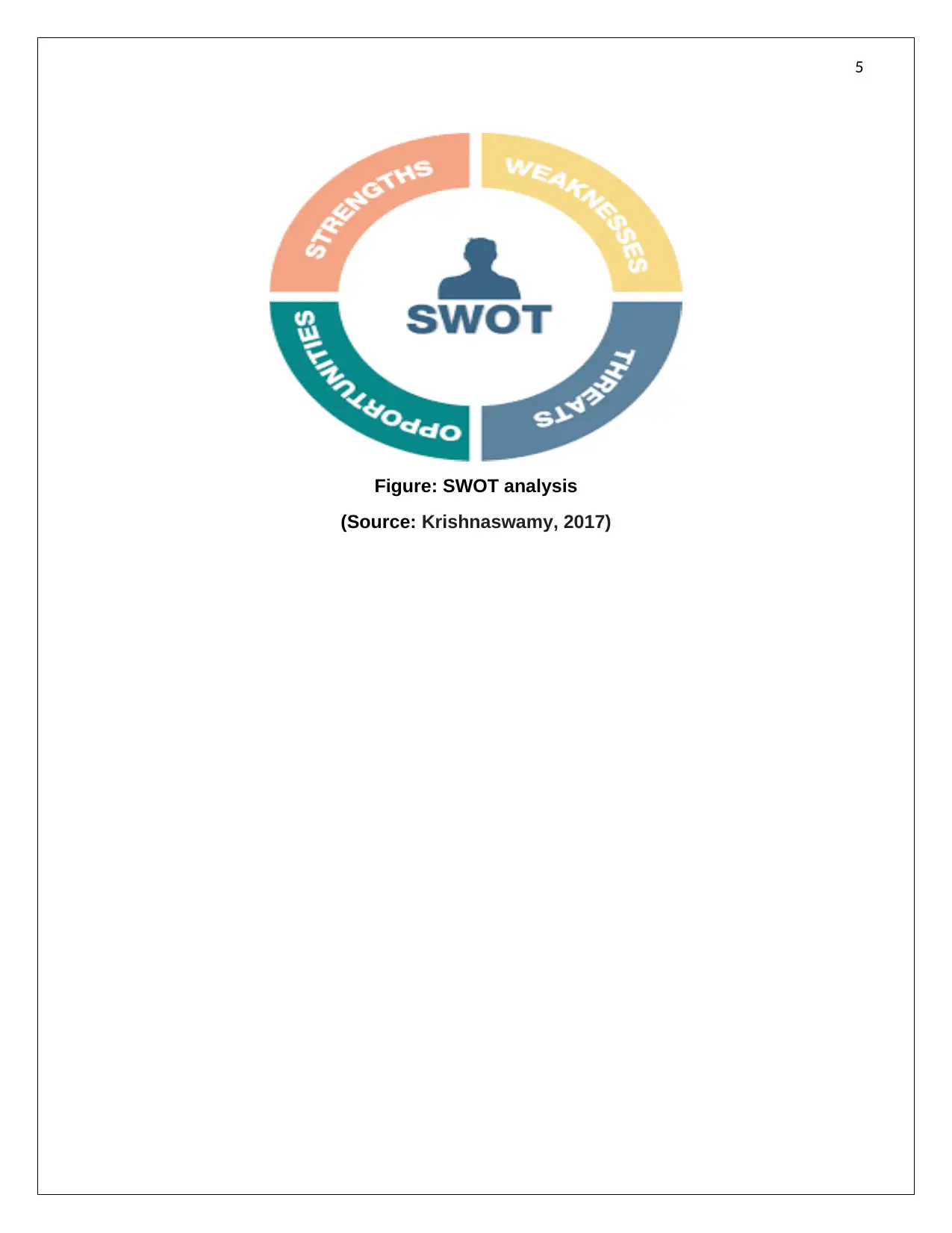
5
Figure: SWOT analysis
(Source: Krishnaswamy, 2017)
Figure: SWOT analysis
(Source: Krishnaswamy, 2017)
⊘ This is a preview!⊘
Do you want full access?
Subscribe today to unlock all pages.

Trusted by 1+ million students worldwide
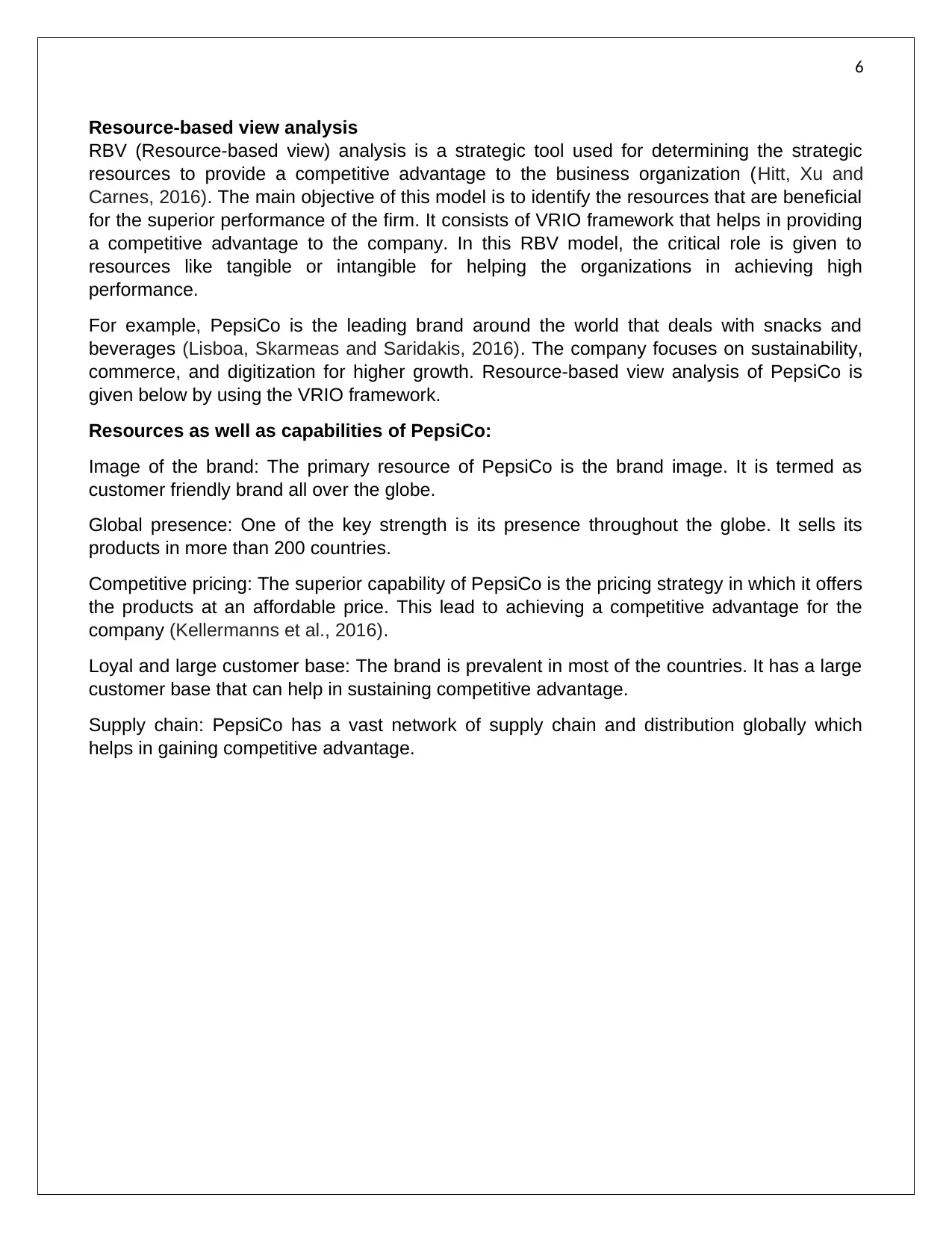
6
Resource-based view analysis
RBV (Resource-based view) analysis is a strategic tool used for determining the strategic
resources to provide a competitive advantage to the business organization (Hitt, Xu and
Carnes, 2016). The main objective of this model is to identify the resources that are beneficial
for the superior performance of the firm. It consists of VRIO framework that helps in providing
a competitive advantage to the company. In this RBV model, the critical role is given to
resources like tangible or intangible for helping the organizations in achieving high
performance.
For example, PepsiCo is the leading brand around the world that deals with snacks and
beverages (Lisboa, Skarmeas and Saridakis, 2016). The company focuses on sustainability,
commerce, and digitization for higher growth. Resource-based view analysis of PepsiCo is
given below by using the VRIO framework.
Resources as well as capabilities of PepsiCo:
Image of the brand: The primary resource of PepsiCo is the brand image. It is termed as
customer friendly brand all over the globe.
Global presence: One of the key strength is its presence throughout the globe. It sells its
products in more than 200 countries.
Competitive pricing: The superior capability of PepsiCo is the pricing strategy in which it offers
the products at an affordable price. This lead to achieving a competitive advantage for the
company (Kellermanns et al., 2016).
Loyal and large customer base: The brand is prevalent in most of the countries. It has a large
customer base that can help in sustaining competitive advantage.
Supply chain: PepsiCo has a vast network of supply chain and distribution globally which
helps in gaining competitive advantage.
Resource-based view analysis
RBV (Resource-based view) analysis is a strategic tool used for determining the strategic
resources to provide a competitive advantage to the business organization (Hitt, Xu and
Carnes, 2016). The main objective of this model is to identify the resources that are beneficial
for the superior performance of the firm. It consists of VRIO framework that helps in providing
a competitive advantage to the company. In this RBV model, the critical role is given to
resources like tangible or intangible for helping the organizations in achieving high
performance.
For example, PepsiCo is the leading brand around the world that deals with snacks and
beverages (Lisboa, Skarmeas and Saridakis, 2016). The company focuses on sustainability,
commerce, and digitization for higher growth. Resource-based view analysis of PepsiCo is
given below by using the VRIO framework.
Resources as well as capabilities of PepsiCo:
Image of the brand: The primary resource of PepsiCo is the brand image. It is termed as
customer friendly brand all over the globe.
Global presence: One of the key strength is its presence throughout the globe. It sells its
products in more than 200 countries.
Competitive pricing: The superior capability of PepsiCo is the pricing strategy in which it offers
the products at an affordable price. This lead to achieving a competitive advantage for the
company (Kellermanns et al., 2016).
Loyal and large customer base: The brand is prevalent in most of the countries. It has a large
customer base that can help in sustaining competitive advantage.
Supply chain: PepsiCo has a vast network of supply chain and distribution globally which
helps in gaining competitive advantage.
Paraphrase This Document
Need a fresh take? Get an instant paraphrase of this document with our AI Paraphraser
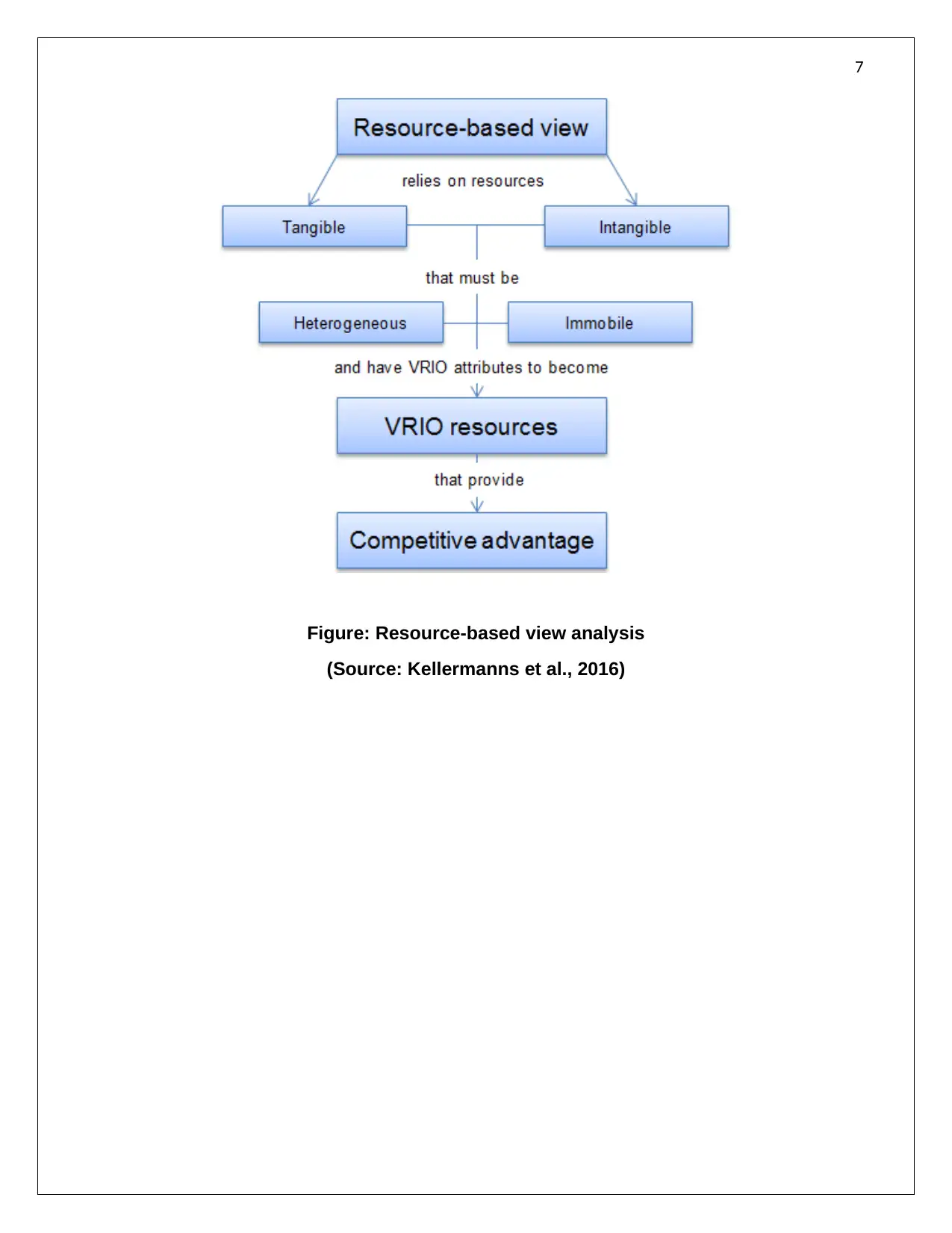
7
Figure: Resource-based view analysis
(Source: Kellermanns et al., 2016)
Figure: Resource-based view analysis
(Source: Kellermanns et al., 2016)
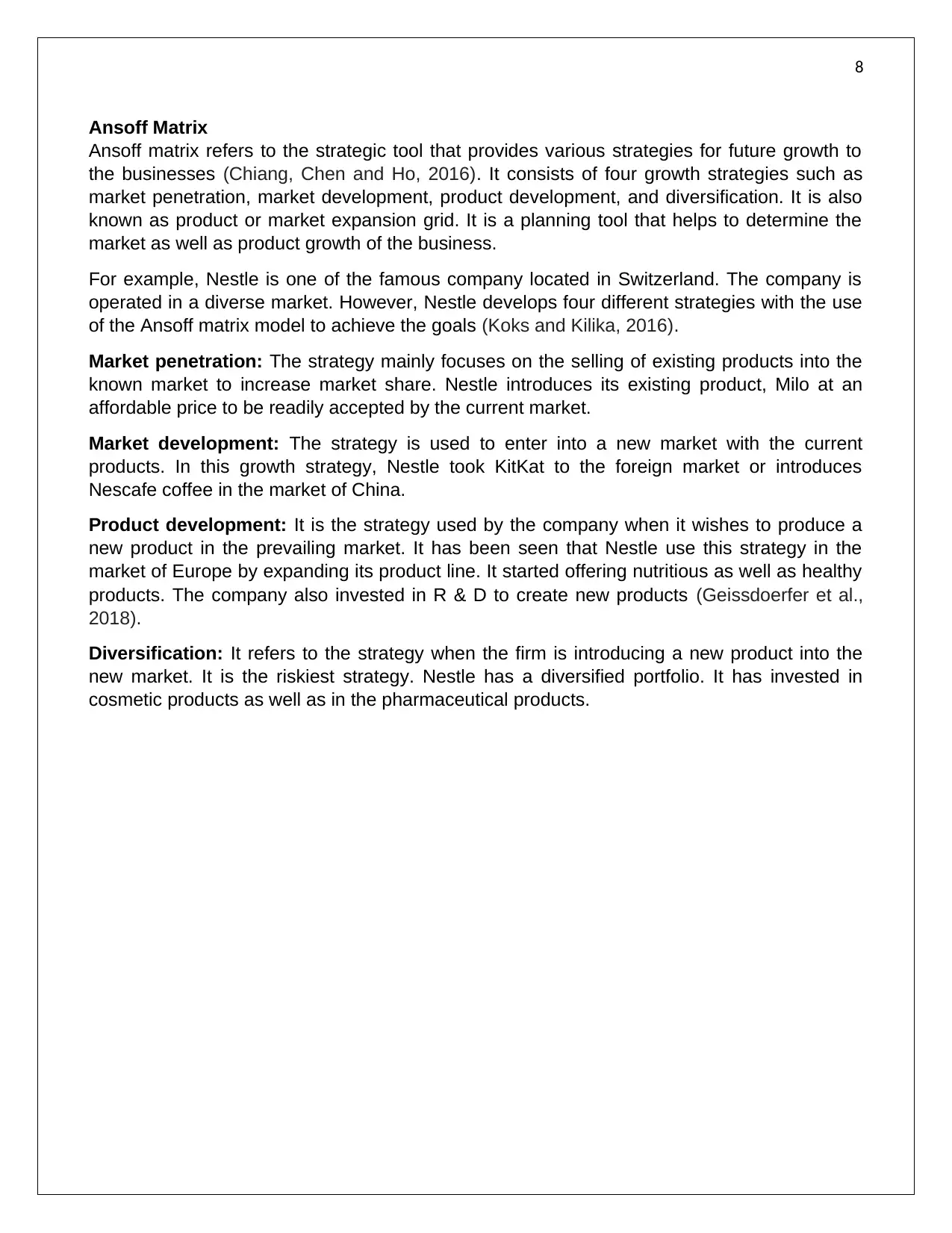
8
Ansoff Matrix
Ansoff matrix refers to the strategic tool that provides various strategies for future growth to
the businesses (Chiang, Chen and Ho, 2016). It consists of four growth strategies such as
market penetration, market development, product development, and diversification. It is also
known as product or market expansion grid. It is a planning tool that helps to determine the
market as well as product growth of the business.
For example, Nestle is one of the famous company located in Switzerland. The company is
operated in a diverse market. However, Nestle develops four different strategies with the use
of the Ansoff matrix model to achieve the goals (Koks and Kilika, 2016).
Market penetration: The strategy mainly focuses on the selling of existing products into the
known market to increase market share. Nestle introduces its existing product, Milo at an
affordable price to be readily accepted by the current market.
Market development: The strategy is used to enter into a new market with the current
products. In this growth strategy, Nestle took KitKat to the foreign market or introduces
Nescafe coffee in the market of China.
Product development: It is the strategy used by the company when it wishes to produce a
new product in the prevailing market. It has been seen that Nestle use this strategy in the
market of Europe by expanding its product line. It started offering nutritious as well as healthy
products. The company also invested in R & D to create new products (Geissdoerfer et al.,
2018).
Diversification: It refers to the strategy when the firm is introducing a new product into the
new market. It is the riskiest strategy. Nestle has a diversified portfolio. It has invested in
cosmetic products as well as in the pharmaceutical products.
Ansoff Matrix
Ansoff matrix refers to the strategic tool that provides various strategies for future growth to
the businesses (Chiang, Chen and Ho, 2016). It consists of four growth strategies such as
market penetration, market development, product development, and diversification. It is also
known as product or market expansion grid. It is a planning tool that helps to determine the
market as well as product growth of the business.
For example, Nestle is one of the famous company located in Switzerland. The company is
operated in a diverse market. However, Nestle develops four different strategies with the use
of the Ansoff matrix model to achieve the goals (Koks and Kilika, 2016).
Market penetration: The strategy mainly focuses on the selling of existing products into the
known market to increase market share. Nestle introduces its existing product, Milo at an
affordable price to be readily accepted by the current market.
Market development: The strategy is used to enter into a new market with the current
products. In this growth strategy, Nestle took KitKat to the foreign market or introduces
Nescafe coffee in the market of China.
Product development: It is the strategy used by the company when it wishes to produce a
new product in the prevailing market. It has been seen that Nestle use this strategy in the
market of Europe by expanding its product line. It started offering nutritious as well as healthy
products. The company also invested in R & D to create new products (Geissdoerfer et al.,
2018).
Diversification: It refers to the strategy when the firm is introducing a new product into the
new market. It is the riskiest strategy. Nestle has a diversified portfolio. It has invested in
cosmetic products as well as in the pharmaceutical products.
⊘ This is a preview!⊘
Do you want full access?
Subscribe today to unlock all pages.

Trusted by 1+ million students worldwide
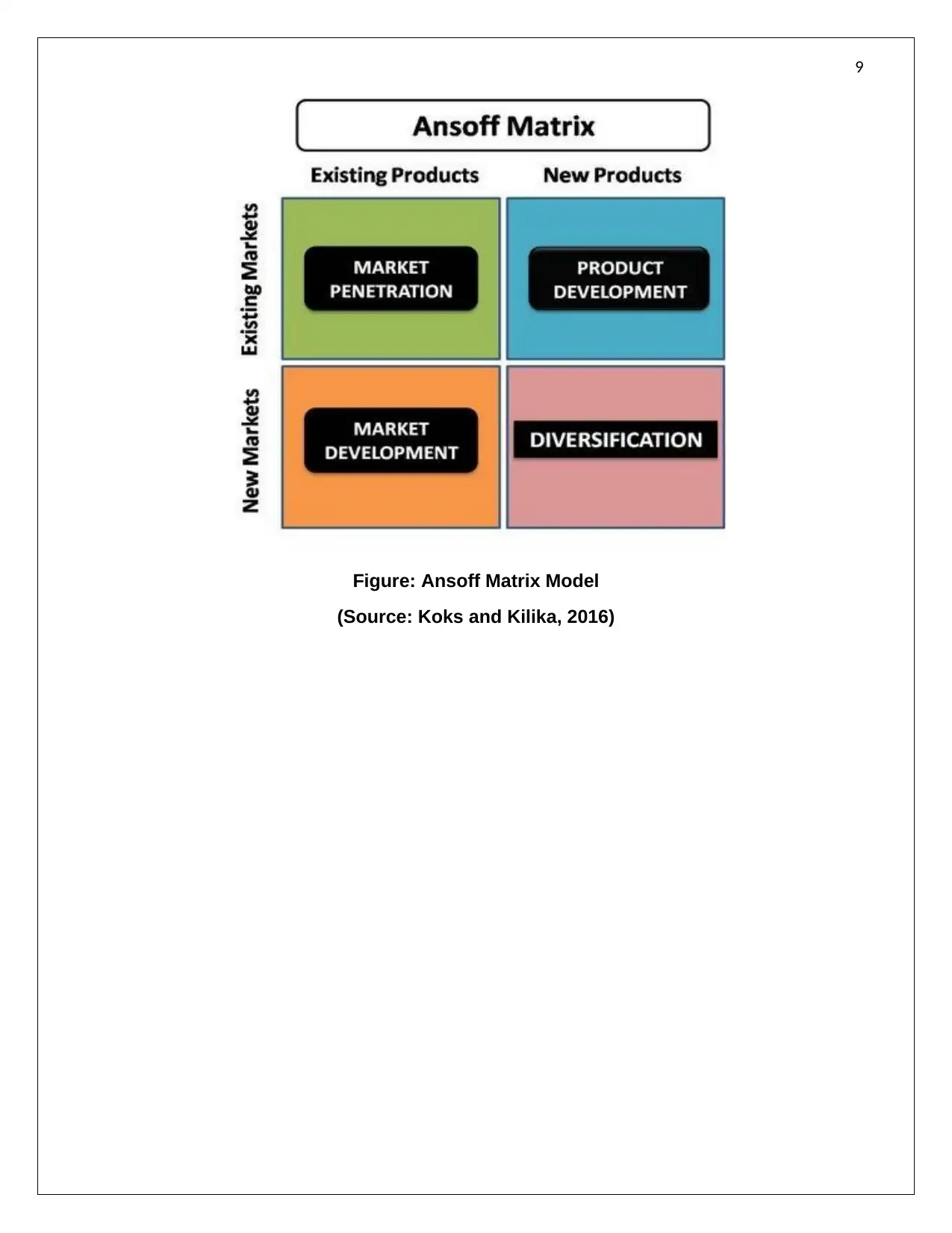
9
Figure: Ansoff Matrix Model
(Source: Koks and Kilika, 2016)
Figure: Ansoff Matrix Model
(Source: Koks and Kilika, 2016)
Paraphrase This Document
Need a fresh take? Get an instant paraphrase of this document with our AI Paraphraser
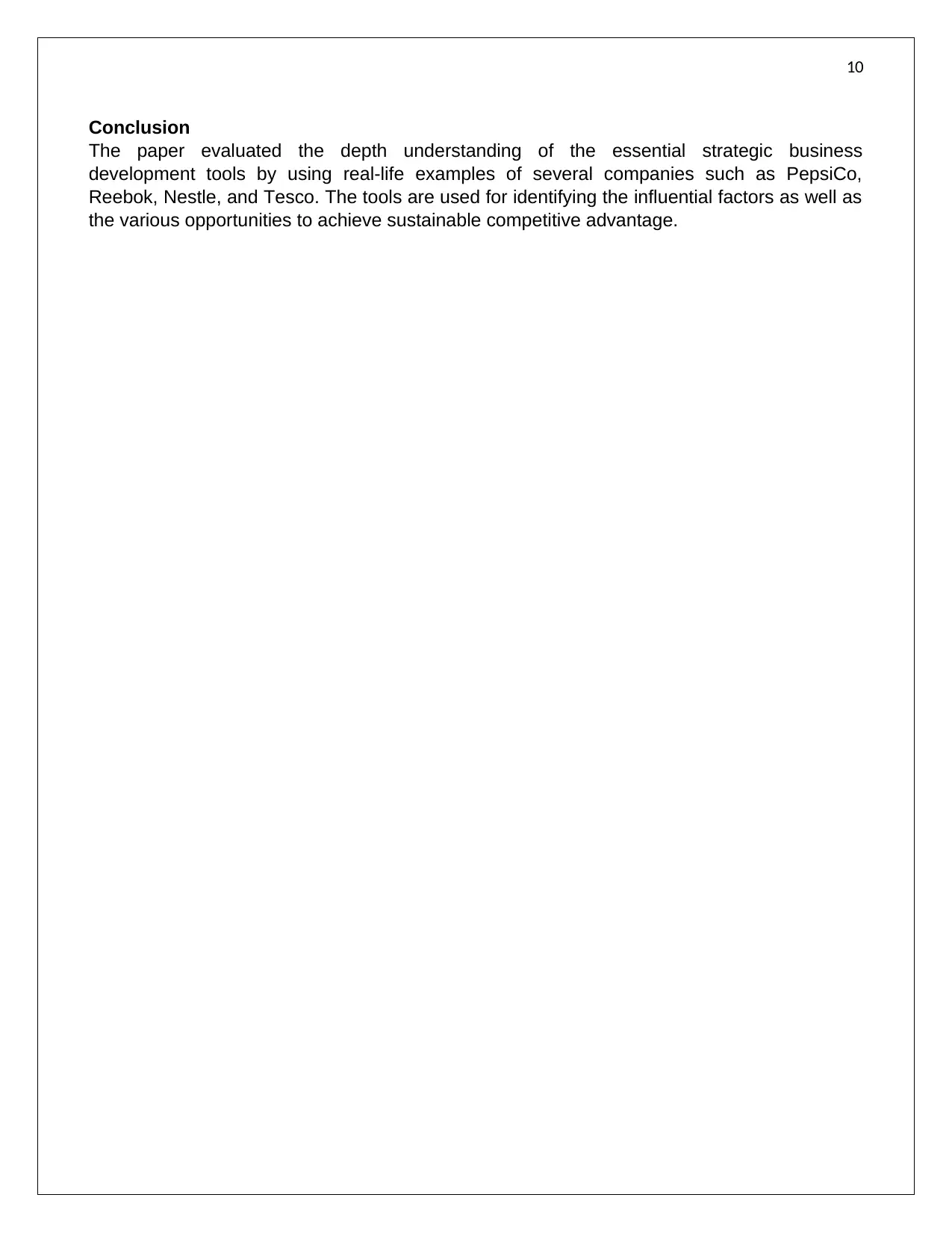
10
Conclusion
The paper evaluated the depth understanding of the essential strategic business
development tools by using real-life examples of several companies such as PepsiCo,
Reebok, Nestle, and Tesco. The tools are used for identifying the influential factors as well as
the various opportunities to achieve sustainable competitive advantage.
Conclusion
The paper evaluated the depth understanding of the essential strategic business
development tools by using real-life examples of several companies such as PepsiCo,
Reebok, Nestle, and Tesco. The tools are used for identifying the influential factors as well as
the various opportunities to achieve sustainable competitive advantage.
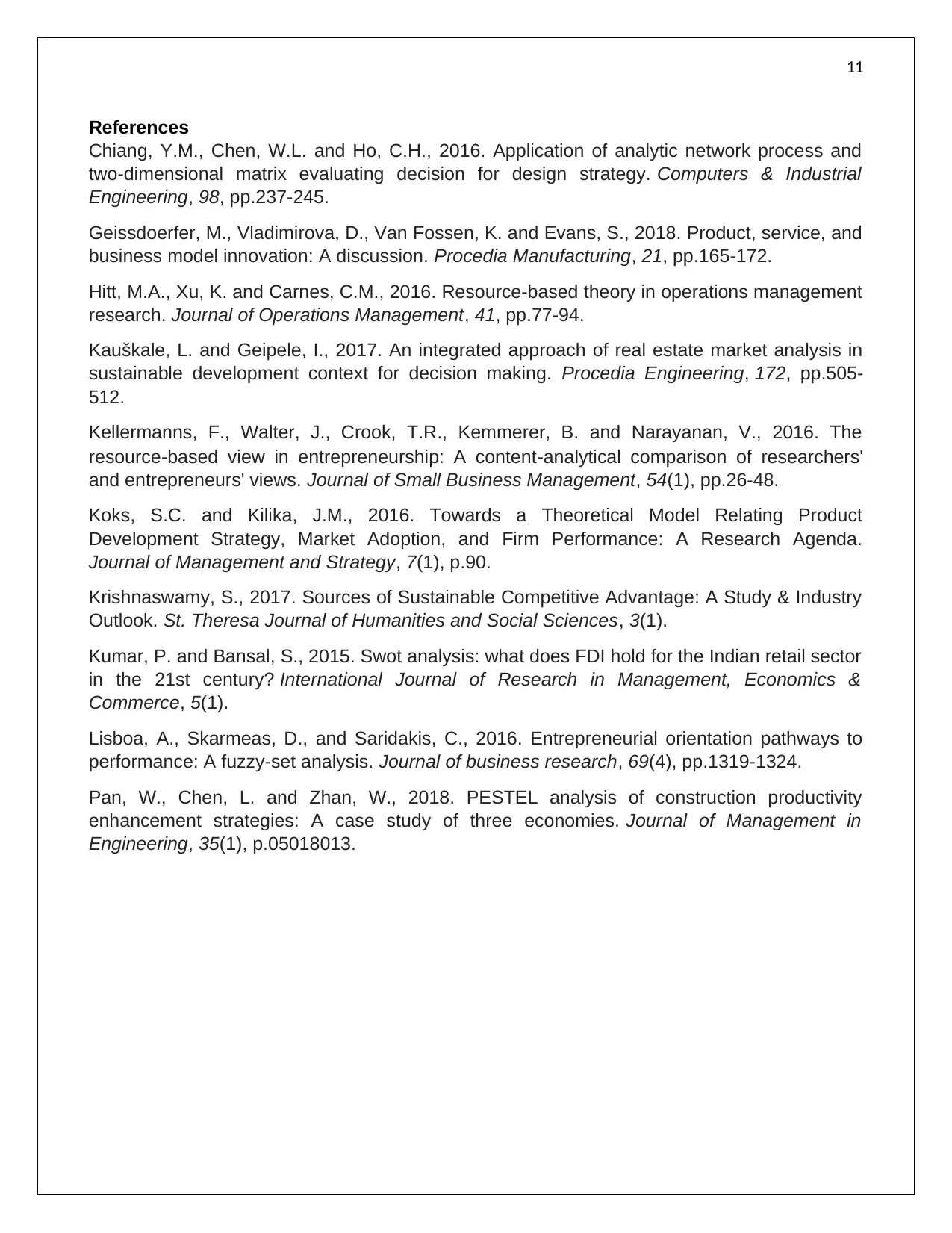
11
References
Chiang, Y.M., Chen, W.L. and Ho, C.H., 2016. Application of analytic network process and
two-dimensional matrix evaluating decision for design strategy. Computers & Industrial
Engineering, 98, pp.237-245.
Geissdoerfer, M., Vladimirova, D., Van Fossen, K. and Evans, S., 2018. Product, service, and
business model innovation: A discussion. Procedia Manufacturing, 21, pp.165-172.
Hitt, M.A., Xu, K. and Carnes, C.M., 2016. Resource-based theory in operations management
research. Journal of Operations Management, 41, pp.77-94.
Kauškale, L. and Geipele, I., 2017. An integrated approach of real estate market analysis in
sustainable development context for decision making. Procedia Engineering, 172, pp.505-
512.
Kellermanns, F., Walter, J., Crook, T.R., Kemmerer, B. and Narayanan, V., 2016. The
resource‐based view in entrepreneurship: A content‐analytical comparison of researchers'
and entrepreneurs' views. Journal of Small Business Management, 54(1), pp.26-48.
Koks, S.C. and Kilika, J.M., 2016. Towards a Theoretical Model Relating Product
Development Strategy, Market Adoption, and Firm Performance: A Research Agenda.
Journal of Management and Strategy, 7(1), p.90.
Krishnaswamy, S., 2017. Sources of Sustainable Competitive Advantage: A Study & Industry
Outlook. St. Theresa Journal of Humanities and Social Sciences, 3(1).
Kumar, P. and Bansal, S., 2015. Swot analysis: what does FDI hold for the Indian retail sector
in the 21st century? International Journal of Research in Management, Economics &
Commerce, 5(1).
Lisboa, A., Skarmeas, D., and Saridakis, C., 2016. Entrepreneurial orientation pathways to
performance: A fuzzy-set analysis. Journal of business research, 69(4), pp.1319-1324.
Pan, W., Chen, L. and Zhan, W., 2018. PESTEL analysis of construction productivity
enhancement strategies: A case study of three economies. Journal of Management in
Engineering, 35(1), p.05018013.
References
Chiang, Y.M., Chen, W.L. and Ho, C.H., 2016. Application of analytic network process and
two-dimensional matrix evaluating decision for design strategy. Computers & Industrial
Engineering, 98, pp.237-245.
Geissdoerfer, M., Vladimirova, D., Van Fossen, K. and Evans, S., 2018. Product, service, and
business model innovation: A discussion. Procedia Manufacturing, 21, pp.165-172.
Hitt, M.A., Xu, K. and Carnes, C.M., 2016. Resource-based theory in operations management
research. Journal of Operations Management, 41, pp.77-94.
Kauškale, L. and Geipele, I., 2017. An integrated approach of real estate market analysis in
sustainable development context for decision making. Procedia Engineering, 172, pp.505-
512.
Kellermanns, F., Walter, J., Crook, T.R., Kemmerer, B. and Narayanan, V., 2016. The
resource‐based view in entrepreneurship: A content‐analytical comparison of researchers'
and entrepreneurs' views. Journal of Small Business Management, 54(1), pp.26-48.
Koks, S.C. and Kilika, J.M., 2016. Towards a Theoretical Model Relating Product
Development Strategy, Market Adoption, and Firm Performance: A Research Agenda.
Journal of Management and Strategy, 7(1), p.90.
Krishnaswamy, S., 2017. Sources of Sustainable Competitive Advantage: A Study & Industry
Outlook. St. Theresa Journal of Humanities and Social Sciences, 3(1).
Kumar, P. and Bansal, S., 2015. Swot analysis: what does FDI hold for the Indian retail sector
in the 21st century? International Journal of Research in Management, Economics &
Commerce, 5(1).
Lisboa, A., Skarmeas, D., and Saridakis, C., 2016. Entrepreneurial orientation pathways to
performance: A fuzzy-set analysis. Journal of business research, 69(4), pp.1319-1324.
Pan, W., Chen, L. and Zhan, W., 2018. PESTEL analysis of construction productivity
enhancement strategies: A case study of three economies. Journal of Management in
Engineering, 35(1), p.05018013.
⊘ This is a preview!⊘
Do you want full access?
Subscribe today to unlock all pages.

Trusted by 1+ million students worldwide
1 out of 12
Related Documents
Your All-in-One AI-Powered Toolkit for Academic Success.
+13062052269
info@desklib.com
Available 24*7 on WhatsApp / Email
![[object Object]](/_next/static/media/star-bottom.7253800d.svg)
Unlock your academic potential
Copyright © 2020–2025 A2Z Services. All Rights Reserved. Developed and managed by ZUCOL.




